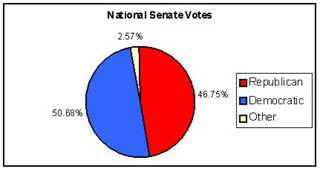Debunking the Realignment Myth

Let the numbers do the talking: "realignment" is a myth, an "is there/isn't there" debate that obscures the real picture. Today's Washington Post piece by John Harris revives the nearly month-old debate on whether this year's election represents a major realignment or just another squeaker. DemFromCT addresses the issue in DailyKos and is cited by the Daou Report and Memeorandum. Here's a number: In the Senate, a difference of less than one-half of one percent would have given Democrats a clear majority. Democrats would be foolish, however, to assume that they can succeed by conducting business as usual. Some imaginative research, and a defensive playbook against an Administration that will use every advantage of incumbency, will be needed if the Democrats are to thrive.
Let's look at those numbers. A difference of only 230,000 votes would have resulted in a deadlocked Senate, and an additional 113,000 votes (less than 400,000 total) would have given Democrats Senate control. That's a change of only 0.046% in total votes cast. Democratic candidates for the Senate received more than 3,000,000 votes than their Republican opponents, as shown here.
Several Republican Senate victory were certifiable squeakers, including a 4500-vote margin in South Dakota (1.16% of votes counted), 10,000 in Alaska (4% of all votes but a low raw number), 22,000 in Kentucky (1.3%), and 78,000 votes in Florida (1%). Then there's that screwball result in Louisiana, where there were four different Democratic candidates. The combined vote for these Democrats was only 66,000 less than the Republican victor's. Democratic victories in these states are achievable.
The Presidential race is another challenge, however. A 51% majority is still a majority. What is even more significant are the trends. Democrats need to be highly sensitive to those trendlines (in the Red states, among evangelicals, by class & ethnicity) that are moving against them. A lot more investigation is needed to determine what factors drove this year's results, and to separate temporary swings from developing trends. Incumbency, terror, media manipulation, evangelical and "moral values" drives, get-out-the-vote, negative campaigning - each was a factor. We need a comprehensive study that weighs these factors and their impact on the race, both nationally and by region. Democrats cannot build a Presidential election strategy without knowing the facts. Detailed analysis of this year's results should be job #1.
Non-voters are still the largest bloc, as this chart shows, and the one least understood. Bush was elected by 31% of eligible voters, while Kerry and other candidates were supported by 30% of eligible voters. "Decline to participate" continues to lead with 39%, a result with intriguing implications. The field of non-participant voter study, which should be an important political science subspecialty, appears fragmented and is certainly poorly understood by most commentators and political consultants. It is a rich and fascinating area of research, and will hopefully receive the attention it deserves.
The Republicans have their reasons for promoting realignment: to discourage their opponents, to create a false sense of "mandate" for a radical conservative agenda, and to create a self-fulfilling prophecy. The media will generally assist in this effort unless challenged, both because it can be 'spun' and because many reporters lack analytic skills. Harris' article is a refreshing exception, but it will be incumbent upon Democrats themselves to frame the discussion differently - both for political reasons, and to ensure that their own analyses are free of false assumptions.
The comments of Howard Wolfson and Mark Gersh in the Post article show both perspective and insight. There is no "major realignment" taking place, but we have an administration that is aggressively using policy and the power of incumbency to shore up its electoral strength. Democrats will need to display quick-wittedness and an ability to see beyond popular assumptions and mythologies if they want to prevail in the coming years. That, plus some innovative research into the behavior and belief systems of non-voters, could help the Democrats move beyond the "realignment myth" and into some creative strategic thinking.

